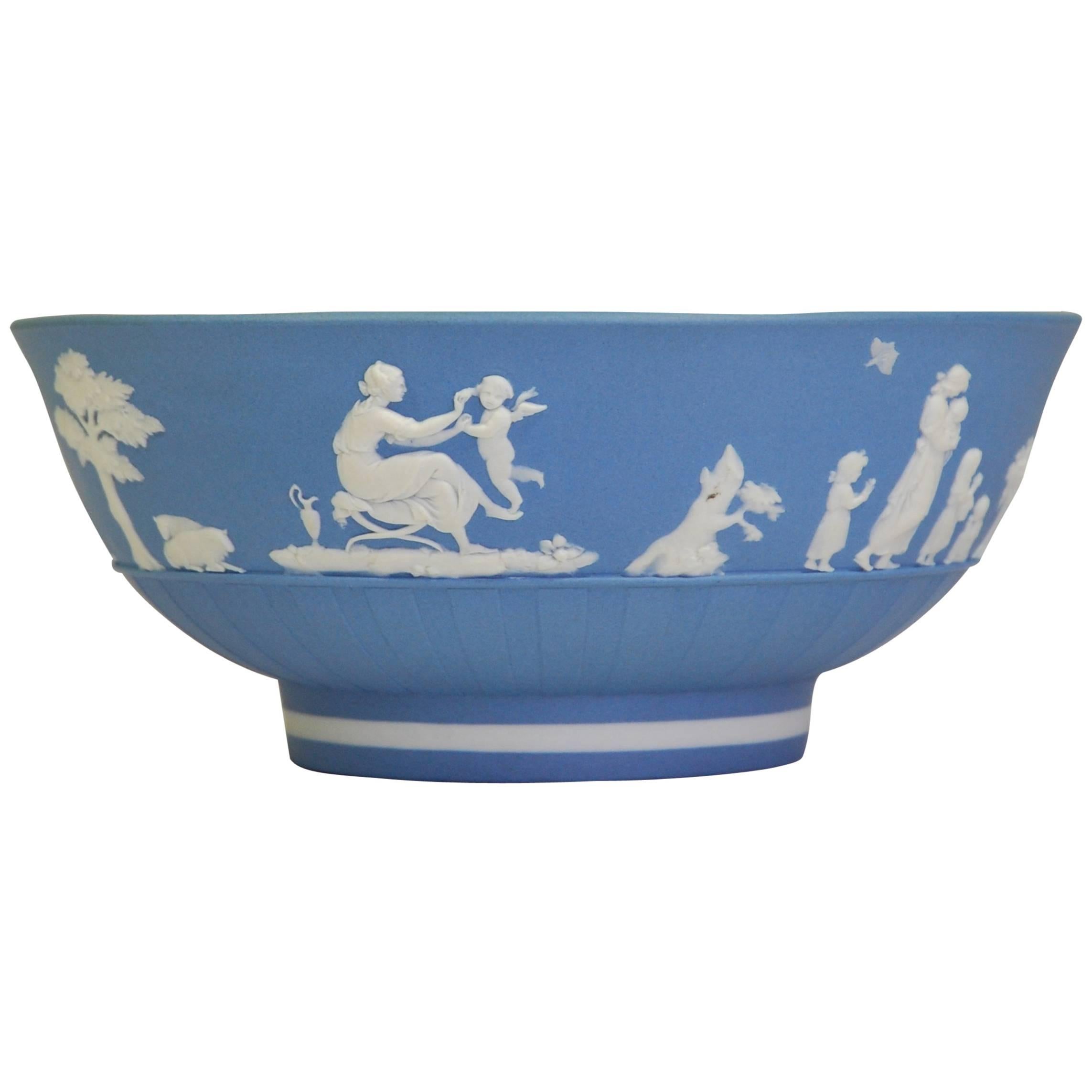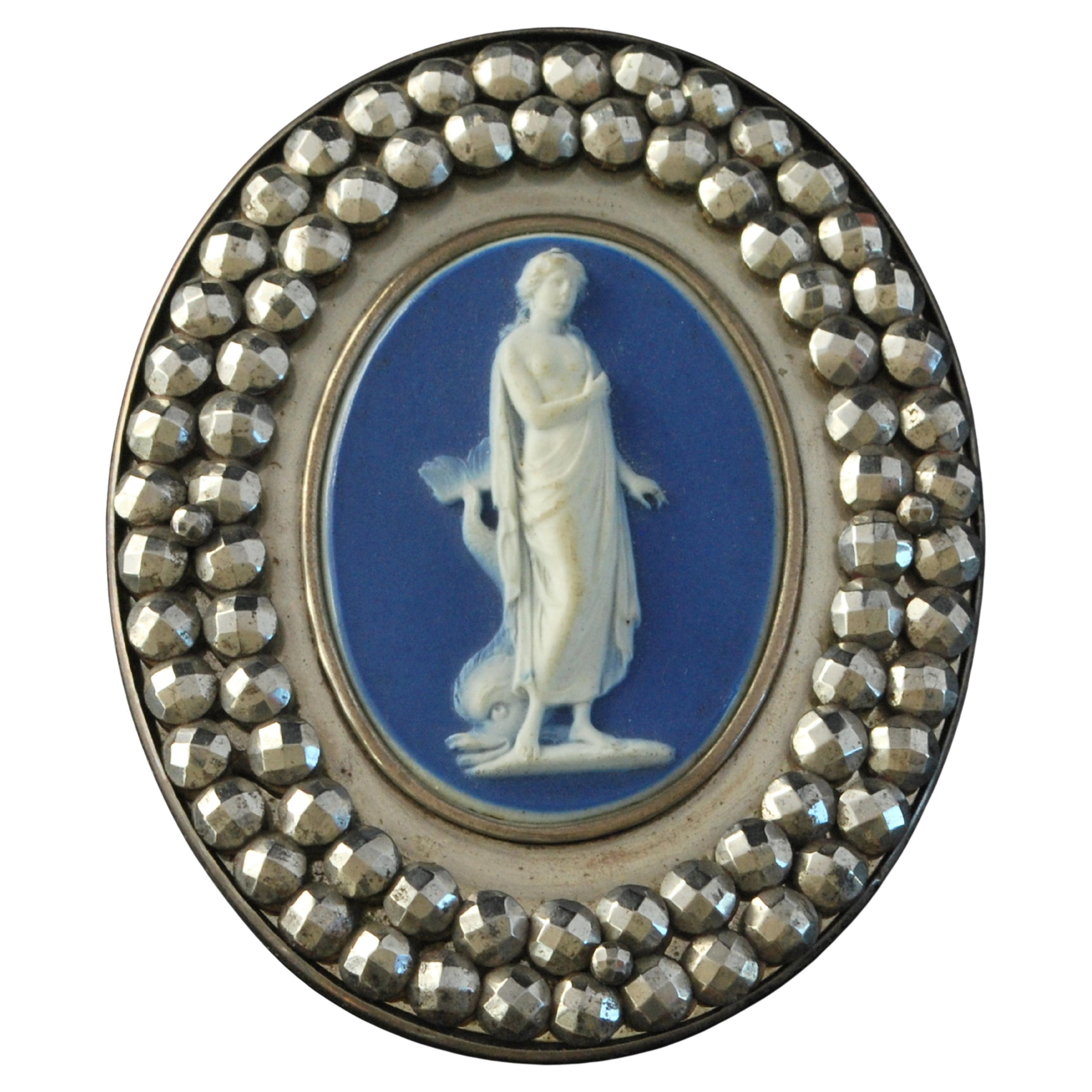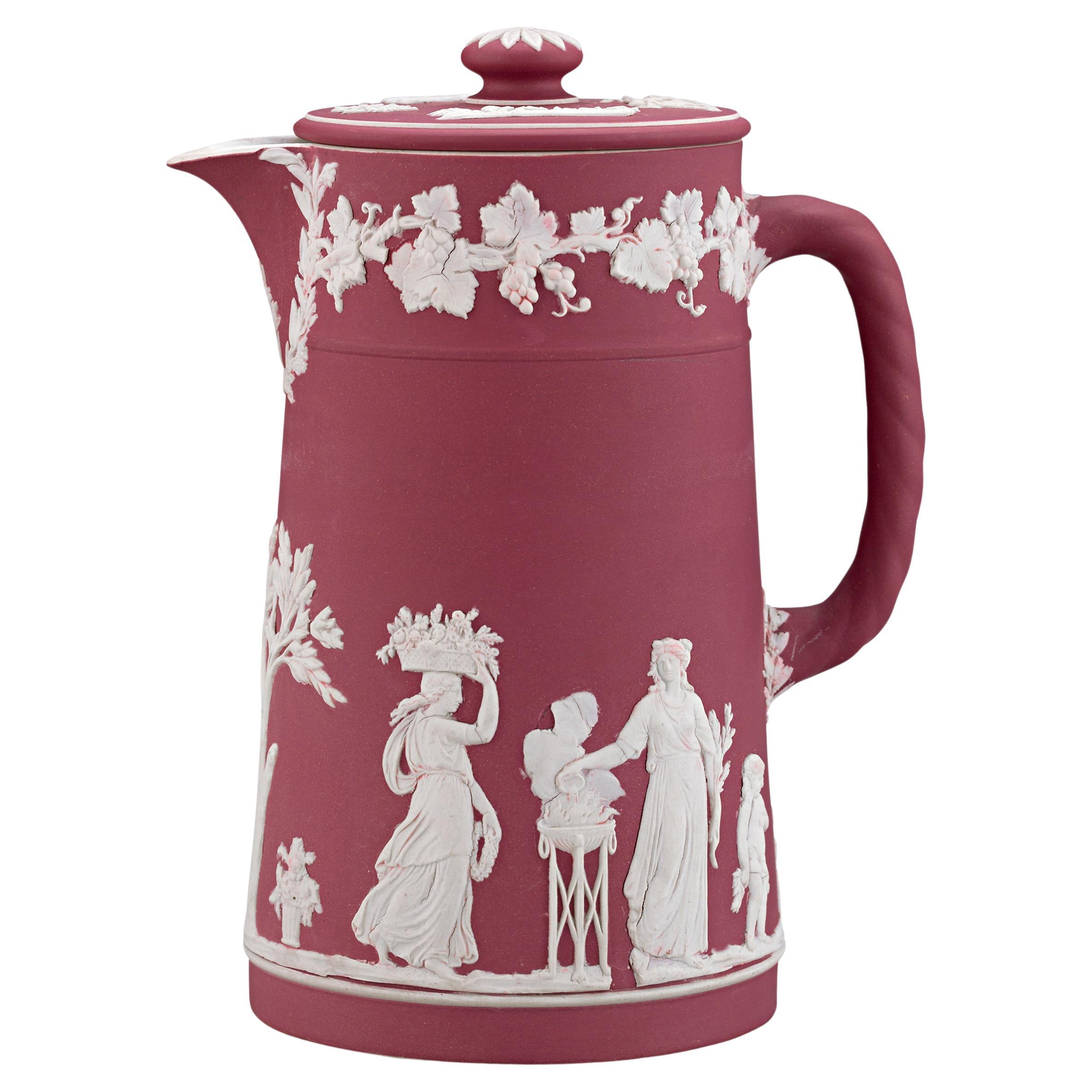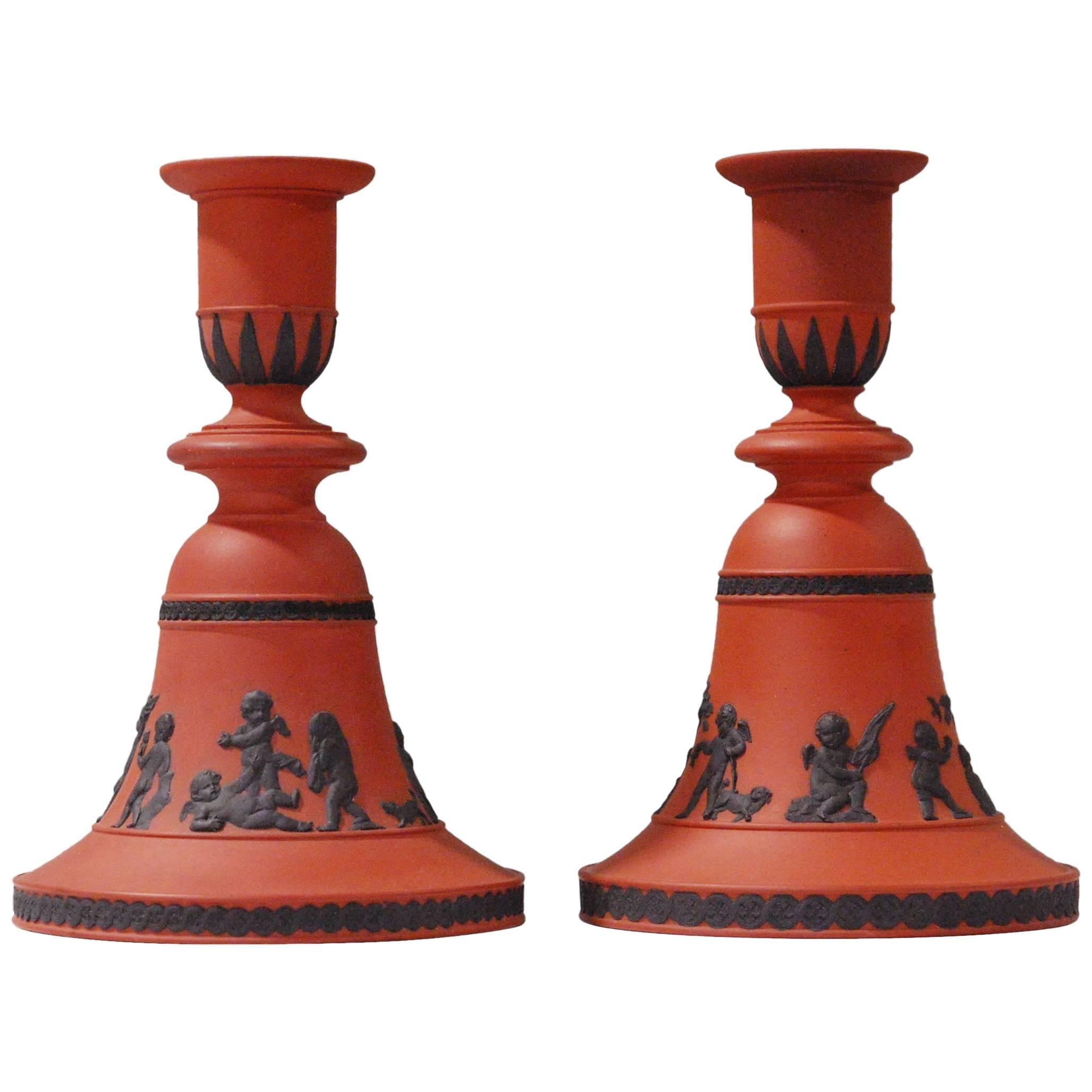Pair of Salts in Slate Blue Jasperware, Wedgwood, circa 1790
About the Item
- Creator:Wedgwood (Manufacturer)
- Dimensions:Height: 2 in (5.08 cm)Diameter: 3 in (7.62 cm)
- Sold As:Set of 2
- Style:Neoclassical (Of the Period)
- Materials and Techniques:
- Place of Origin:
- Period:
- Date of Manufacture:circa 1790
- Condition:Wear consistent with age and use. Edge chips as shown.
- Seller Location:Melbourne, AU
- Reference Number:
Wedgwood
Arguably the most celebrated of all English ceramics makers, Wedgwood was founded in 1759 by Staffordshire potter Josiah Wedgwood (1730–95). The company is famed for its Jasperware — molded Neoclassical stoneware vases, plates and other pieces, inspired by ancient cameo glass, featuring white figures, scenes and decorative elements set in relief on a matte colored background. The best-known background hue is light blue, but Wedgwood’s iconic silhouettes also appear on green, lilac, yellow, black and even white grounds. Some pieces use three or more colors.
The Wedgwood firm first came to prominence for its tableware, which quickly gained favor in aristocratic households throughout Britain and Europe. In 1765, Wedgwood was commissioned to create a cream-colored earthenware service for Queen Charlotte, consort of King George III. The queen was so thrilled with her new china that Wedgwood was given permission to call himself “Potter to Her Majesty,” and the decorative style became known as Queen’s Ware. Not to be outdone, Catherine the Great of Russia commissioned her own set of Wedgwood china in 1773. Nearly 200 years later, the firm created a 1,200-piece service for the coronation of Queen Elizabeth II. In recent years, leading designers including Jasper Conran and Vera Wang have collaborated with Wedgwood — in the tradition of such distinguished 18th century artists such as the painter George Stubbs and metalsmith Matthew Boulton.
From plates and other dinnerware to decorative items like urns, cachepots and candlesticks, Wedgwood designs lend a traditional air to Anglophile interiors. And even if you have to make your own tea, you may find it comforting to sip it from a delicate cup that was manufactured in the same Stoke-on-Trent kiln that produced Her Majesty’s tea service. Be sure to keep your pinky raised.
- ShippingRetrieving quote...Ships From: Melbourne, Australia
- Return PolicyA return for this item may be initiated within 14 days of delivery.
- Pale Blue Jasperware Bowl, Wedgwood, circa 1790By WedgwoodLocated in Melbourne, VictoriaIn solid slate blue jasper, with inlaid foot; decorated with numerous reliefs typical of the period. Engine turned decoration and lapidary polished interior. Exhibited: Wedgwood, Ma...Category
Antique 1790s English Neoclassical Pottery
MaterialsStoneware
- Potpourri in Cobalt Jasperware, Wedgwood, circa 1820By WedgwoodLocated in Melbourne, VictoriaA broad, flat potpourri in cobalt jasper dip, with a tall pierced cover.Category
Antique Mid-19th Century English Neoclassical Pottery
MaterialsPottery
- Jasperware Buckle, Wedgwood, Matthew Boulton, Circa 1795By WedgwoodLocated in Melbourne, VictoriaA jasper medallion decorated with Aphrodite, set in cut steel as a buckle, probably by Matthew Boulton. Original box. The Greek goddess Aphrodite is often depicted in ancient art with a dolphin. In mythology, dolphins were considered sacred to Aphrodite, and they were associated with love, beauty, and fertility. According to one legend, Aphrodite emerged from the sea on a shell-borne chariot drawn by dolphins, and the creatures were said to be her faithful servants. As a result, images of Aphrodite with dolphins became a popular motif in Greek art, appearing on vases, sculptures, and other decorative objects. The association between Aphrodite and dolphins has continued through the centuries, and the image of the goddess with a dolphin remains a popular symbol of love and beauty. Matthew Boulton (1728-1809) was an English manufacturer and entrepreneur who was best known for his contributions to the Industrial Revolution...Category
Antique Mid-19th Century English Neoclassical Pottery
MaterialsCut Steel
- Encaustic Painted Ecuelle, Wedgwood, circa 1790By WedgwoodLocated in Melbourne, VictoriaIn black basalt, decorated with encaustic painting. An écuelle is a French word that refers to a shallow dish or bowl, typically made of metal or ceramic, and used for serving food. Écuelle is also the French word for a small, shallow saucer used for serving soup. In English, an écuelle might be referred to as a soup plate or a soup saucer...Category
Antique 1780s English Neoclassical Pottery
MaterialsStoneware
- Pair of Rosso Antico Candlesticks, Wedgwood, circa 1820By WedgwoodLocated in Melbourne, VictoriaA rare pair of bell shaped candlesticks in rosso antico, with black decoration of ‘Boys at Play’.Category
Antique Early 19th Century English Neoclassical Pottery
MaterialsStoneware
- Jasperware Perfume Bottle, William Adams, circa 1790By William AdamsLocated in Melbourne, VictoriaIn cobalt jasper, decorated with Androcles and the lion and Demeter, Goddess of the harvest; Aphrodite to the other side. Original bright cut silver ...Category
Antique Mid-18th Century English Neoclassical Pottery
MaterialsStoneware
- Wedgwood Crimson Jasperware PitcherBy WedgwoodLocated in New Orleans, LAThis striking Wedgwood crimson dip bas-relief covered jug features an applied white jasper neoclassical decoration of grapevines bordering the rim. De...Category
20th Century English Neoclassical Pottery
MaterialsPottery
- Wedgwood Creamware Platter or Charger 18th Century Made in England Circa 1785By WedgwoodLocated in Katonah, NYThis Wedgwood creamware round platter or charger was made in 18th century England circa 1785. The border is decorated with a traditional neoclassical design of iron-red flower heads...Category
Antique Late 18th Century English Neoclassical Decorative Dishes and Vid...
MaterialsCreamware
- Pair of Antique Jasperware Vases by Adams Pottery, circa 1780By William Adams (Potter)Located in London, GBPair of antique jasperware vases by Adams Pottery, circa 1780 English, c. 1780 Height 27cm, diameter 10cm This remarkable pair of neoclassical blue jasperware vases stands as a testament to the sublime artistry and finesse of William Adams, an eminent member of the illustrious Adams pottery family of the 18th century. The vases showcase an exceptional three-dimensional frieze in crisp white relief, vividly portraying scenes from classical mythology. Central to these intricate designs are Apollo, the Greek god of sun and music, and Cupid, the divine symbol of love and attraction. The high-relief technique lends the figures a sense of dynamic realism, setting them vividly against the blue jasperware, and are excellent examples of neoclassical decorations. Complementing the classical friezes are formal borders that encircle the shoulders of each vase. These meticulously crafted embellishments contrast brilliantly with the blue Jasper, accentuating their own elaborate detailing. Adding to the grandeur of these pieces are the tall plinth bases, which are graced by classical figures emblematic of the four seasons, also in white relief. These figures not only augment the classical look of the vases but also represent the perennial cycle of life and the passage of time. The bases also feature classical friezes to the sides and bottom. Each vase proudly bears the unmistakable 'ADAMS' impression, signifying their provenance and certifying their authenticity. This signature mark is a cherished attribution to their creator, William Adams, and his significant contribution to the heritage of pottery. William Adams, a favoured pupil of the legendary Josiah Wedgwood, established his own pottery in 1789 and became renowned for his work with Queensware, painted china glaze ware, transfer ware, basalt, and jasperware until his death in 1805. The Adams family...Category
Antique 18th Century English Neoclassical Pottery
MaterialsOther
- Set 18 Wedgwood Creamware Dessert or Salad Dishes England, circa 1820By WedgwoodLocated in Katonah, NYMade in England in the early 19th century, circa 1815, these Wedgwood dessert or salad dishes are a beautiful and sophisticated set. The combination o...Category
Antique Early 19th Century English Neoclassical Dinner Plates
MaterialsCreamware
- Wedgwood Pearlware Fox Hunting Jug, circa 1810By WedgwoodLocated in Downingtown, PAWedgwood pearlware fox hunting jug, circa 1810. This ovoid jug has a cylindrical neck, a projecting lip, and a ribbed ear-shaped loop handle. Bat prin...Category
Antique Early 19th Century English Georgian Pitchers
MaterialsPearlware, Pottery
- Wedgwood Pair Unusual Figural Creamware Sauce BoatsBy WedgwoodLocated in Bishop's Stortford, HertfordshireAn unusual and scarce pair Wedgwood creamware sauce boats or dishes with swan neck handles and raised molded Bacchus heads dating from 1912. The dishes are lightly potted and are simply decorated with black spot outlines and feathered pattern around the edges of the dish. The dishes have impressed marks to the base along with printed WEDGWOOD ETRURIA ENGLAND...Category
Vintage 1910s English Egyptian Revival Serving Pieces
MaterialsPottery






